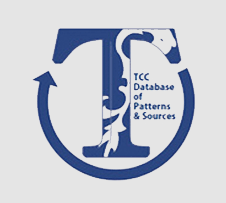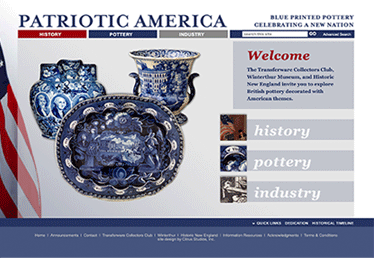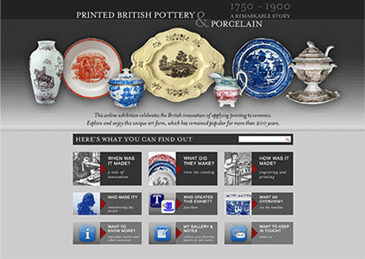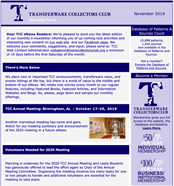


18,700 patterns and 1,139 sources and still growing.
Each month we feature a new pattern from our Pattern and Source Print Database and archive them on these pages.
Members only: for more information about these patterns and to see other similar patterns, search the Pattern and Source Print Database.
(Click on thumbnails to see larger images)
Seen here is a 9.75 inch plate printed in black and red in the Ayam-Jantan pattern made by J & M P Bell & Co. (1842-1928) in Glasgow Scotland. The Rd. Number, 17429, is circa 1891. The pattern has a non-English descriptive title as it was intended for the South East Asia market. Visit more information and other archived patterns to learn more about this pattern.
This Aesthetic pattern 7.5 inch plate was made by James Broadhurst & Sons Ltd. (1847-1984). The pattern was registered March 16, 1883. Members only: for more information about this pattern and to see other similar patterns, search the Pattern and Source Print Database.
Maker Unknown. This pattern is shown on a pearlware well and tree platter measuring 13 5/8” by 18 1/4” and is printed in underglaze blue with overglaze clobbering in shades of rust red and ochre enameling on the edge. The added coloring is unusual on a pattern of this type. Found on the back is an impressed “18” mark indicating the size of the dish and a blue hand painted “X” printer's mark. The border incorporates geometric shapes and picture medallions. Examples are known both with and without the name 'Wear Sc.' at the end of a fence in the design. [Not present on this piece.] The pattern is frequently attributed to Andrew Stevenson of Cobridge, Staffordshire, on the grounds of its resemblance to other marked similar patterns.
"Clyde Scenery" printed in underglaze pink(red) by John & Job Jackson (1831-1835). The central pattern is different on each size and shape. The river Clyde runs through Glasgow, so that although this is an unidentified view, it is probably easy to research. The pattern is also printed in purple, black, brown, blue and teal green.
Seen here is a 10.5 inch plate printed in the "Congo" pattern by Forester & Hulme (1887-1892). It is common for an Aesthetic pattern to have a place name as the title, although the birds and plants here seem to have little to do with the Congo. Members only: for more information about this pattern and to see other similar patterns, search the Pattern and Source Print Database.
Shown here is a 6.5 inch plate featuring Cowes Harbour. Cowes Harbour is located in the town of Cowes on the Isle of Wight in Britain. The pattern is part of the large Enoch Wood & Sons Irregular Shell Border Series, ca. 1825. The series is best known for its American Historical views, but includes a few British views. Notice that the title of the scene is printed in the left-hand corner of the center.
Shown on both a 9 inch plate and 13 inch comport, this view features a seated figure piping. The pattern is attributed to Careys on the basis of a piece bearing the factory mark and series name on a ribbon (FOB True Blue p. 86, Case 31/2). Cattle is the old English word for domestic animals, while today we only think of cows as cattle.
"Durham Ox With John Day" by an unknown maker is found on a 21 inch by 17 inch platter. It was copied from an engraving by T.Whessell after a painting by T. Boultbec. See the engraving. The Durham Ox is actually only found on this pattern and the 10" plate and soup plate. The rest of the series portrays rural scenes with cows and cowmen.
Giraffe markShown here is a 10 inch plate in the "Giraffe" pattern made by John Ridgway (1830-1841) to commemorate the giraffes brought to the new London Zoological Gardens in 1836. The pattern is the same on the entire dinner service. It also appears on a tea service, but with a different border. "Giraffe" was a very popular pattern. It was printed in every color except yellow.
Shown here is a Spode plate in the Lange Lijsen pattern, ca. 1810-1833. It was copied from a Chinese hand-painted pattern from the K'ang Hsi period, ca. 1700-1722.
The 4 inch miniature plate seen here is a Chinese hand-painted pattern with a simple version of the Long Eliza or Jumping Boy center pattern. The border is not elaborate on such a small piece.
Rich with content for ceramic collectors, researchers, authors, curators, and historic archaeologists, the sites are sure to deliver value for their visitors. The exhibition’s curators continue to enhance them and, now, with site application upgrades, including a new magnification feature and upgraded content management capabilities, the TCC and its collaborators are pleased to relaunch these exhibits, all free to a worldwide audience.

Branded Patriotic America, debuted in 2014 in collaboration with Historic New England, and the Winterthur Museum

Launched in 2015 in partnership with the Northern Ceramic Society.
 Not a member but want to receive email updates?
Not a member but want to receive email updates?